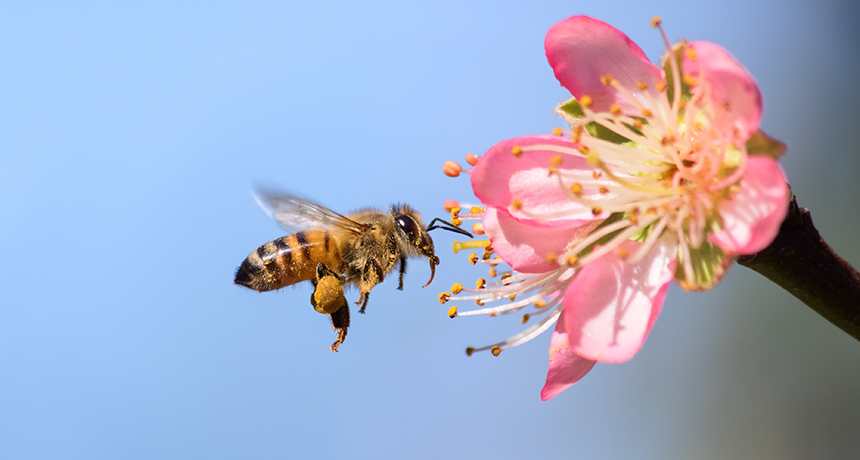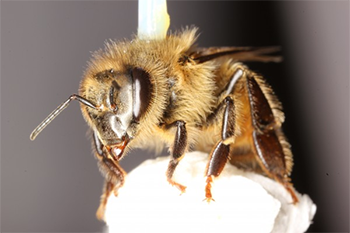Popular pesticide may harm bee flight
Honeybees in the lab were sluggish after drinking nectar tainted with this chemical

Bees have to fly to collect food and water, so bee flight is important to the health of the hive. But pesticides might interfere, data now show.
SumikoPhoto/iStockphoto
Farmers use pesticides to keep insect pests from destroying their crops. But these chemicals may accidentally harm helpful insects. Some pesticides can hurt a honeybee’s ability to find food and return home. Now scientists show that at least one commonly used insecticide may alter bee flight. In a new study, this chemical made honeybees fly more sluggishly.
Pesticides of this type are called neonicotinoids (Nee-oh-NIK-ih-tin-oidz). Sometimes referred to as neonics, they’re similar to nicotine. That’s the natural, stimulant drug in tobacco. Many studies have concluded that these chemicals could be bad for bees. Now scientists are looking for new ways to get rid of crop pests without harming bees and other beneficial insects, notes James Nieh. A bee biologist, he works at the University of California, San Diego.
Bees are one of several insects that do the important job of pollinating plants. Honeybee workers fly from flower to flower, drinking and collecting a sweet liquid called nectar. (Back at the hive, that nectar is turned into honey.) As the bees take off and land, again and again, they transfer pollen grains from one plant’s male parts to another plant’s female parts. This pollination can fertilize plants. That lets them make seeds — and later, fruit.
Nieh and UC San Diego colleague Simone Tosi had read that honeybee workers exposed to a popular neonic flew away from the hive and never returned. They started wondering why. “Did they drop dead, lose their way — or were they physically unable to fly back?” Nieh wondered.

To find out, they gathered honeybees that were collecting food on flowers near the university. They brought the bees back to their laboratory. Then they made itty bitty harnesses for their tiny research subjects.
The researchers attached each bee to a spoke on a machine called a flight mill. “Imagine a carousel for bees,” says Tosi. The bees flew in circles on the flight mill while the researchers measured their speed and how long and far the insects flew.
The researchers fed some of the bees a mix of sugar water (a stand-in for nectar) that was laced with pesticide. Then they harnessed the insects to the flight mill. They wanted to mimic how a bee in the wild might encounter a pesticide — through its food. The pesticide was a popular neonic called thiamethoxam (Thy-ah-METH-oh-zam). Plants treated with it take up the chemical into their leaves as they grow. That way the leaves can fight off hungry insects.
But some of the pesticide ends up in the pollen. And that’s where bees can get exposed. They usually won’t get enough pesticide to kill them. But some scientists think small doses of the poison might make bees act a little loopy.
And the new data now suggest that indeed it does.
After one dose of pesticide, bees flew longer and farther than other bees. But if they got more of the pollutant, they now flew shorter distances. The bees also stayed in the air for less time and flew more slowly. The researchers described their findings April 26 in Scientific Reports.
Story continues below video.
Too much buzz?
Nieh and Tosi aren’t exactly sure why the bees flew more after one dose of pesticide and less after several. Neonics can scramble an insect’s nervous system. That’s the network of nerve cells that carry messages between the brain and other parts of the body. Nieh says it’s possible that the first dose makes a bee hyperactive. Over several doses, however, too much “buzz” might lead to exhaustion.
Flying too much or too little might both be harmful, Tosi worries. Longer flights mean more chances to get eaten by birds or other predators. But shorter flights could mean the bees don’t forage long enough to bring sufficient food back to the hive.
“It’s an interesting finding,” says Dave Goulson, who wasn’t involved in the research. “But the study doesn’t enable us to make any clear predictions about what real-world effects this might be having on bees.” Goulson is a bee researcher at the University of Sussex in Brighton, England.
Laboratory studies such as this one can be useful. They let researchers test ideas about how things in nature work. Moreover, they can rule out other variables, such as weather or predators. Such factors might interfere with the results if the tests had been conducted outdoors.
Still, there are trade-offs, Goulson points out. Lab conditions don’t capture all real-world conditions. For example, bees in nature are expert navigators. They use visual landmarks, the sun and other cues to find their way home. But there were no navigational landmarks in the flight mill. “Maybe in the real world, bees wouldn’t fly as far, because they’d be able to find their way home,” he says.
Tosi says he’d like to test the effects of the pesticide on other types of bee movements next. “How they move their body and legs while on a flower or inside the hive could also be affected,” he notes.







